
Il Palio di Siena is often depicted as a thrilling and vibrant celebration of tradition and community. However, beneath the colorful pageantry lies a darker side that has raised eyebrows and sparked debates both in Italy and beyond.
The Allure of Tradition
Il Palio di Siena, held twice a year in the Piazza del Campo, is a spectacle that draws thousands of spectators. This medieval horse race, dating back to the 17th century, is steeped in tradition and fervor. The city’s 17 contrade, or districts, fiercely compete for the coveted Palio banner, symbolizing honor and pride. The race is not just a sporting event; it’s a cultural phenomenon deeply embedded in Sienese life.
The Dark Side of Glory
While the race’s historical significance and cultural value cannot be denied, the risks and ethical concerns it presents are equally undeniable. The intense rivalry and high stakes often lead to dangerous and, at times, tragic outcomes. Horse accidents are not uncommon, and the injuries sustained by both animals and jockeys can be severe. Over the years, several horses have been fatally injured during the race, leading to an outcry from animal rights activists.
The Shocking Dangers to Horses
The most glaring issue surrounding Il Palio is the welfare of the horses. Despite precautions, the nature of the race and the challenging course through the cobbled streets of Siena pose significant risks. Horses race at breakneck speeds around the tight, uneven turns of the Piazza del Campo. The potential for falls and collisions is high, and the injuries sustained can be devastating.
Animal welfare organizations have long condemned the race for its treatment of the horses. Reports of horses being drugged or pushed beyond their physical limits have surfaced, adding to the controversy. The lack of adequate safety measures and the prioritization of tradition over animal welfare are shocking aspects that tarnish the event’s reputation.

The Human Cost
The jockeys, too, face considerable dangers. Riding bareback, they navigate the treacherous course while contending with aggressive competition. The absence of modern safety gear leaves them vulnerable to serious injuries. Over the years, numerous jockeys have suffered fractures, concussions, and other injuries. The pressure to win can lead to dangerous tactics, further escalating the risks involved.
A Battle of Ethics
The ethical dilemma surrounding Il Palio is a contentious topic. Supporters argue that the race is an essential part of Sienese heritage and should be preserved at all costs. They point to the economic benefits, the sense of community it fosters, and the deep-rooted traditions it upholds. For many, Il Palio is more than just a race; it’s a celebration of identity and history.
On the other hand, critics argue that no tradition should come at the expense of animal and human welfare. They advocate for reforms to ensure the safety of both horses and jockeys. Some even call for the abolition of the race altogether, deeming it an outdated and cruel practice. The debate continues to rage, with passionate arguments on both sides.
The Road to Reform
In response to growing criticism, efforts have been made to enhance safety measures at Il Palio. Protective padding on the dangerous turns, stricter regulations on horse treatment, and veterinary checks have been introduced. However, these measures have not fully allayed the concerns of critics. Many believe that more stringent reforms are necessary to protect the welfare of all participants.
The challenge lies in balancing tradition with modern ethical standards. The city of Siena faces the difficult task of preserving its cultural heritage while addressing the legitimate concerns raised by opponents of the race. Finding this balance is crucial to ensuring that Il Palio can continue without compromising the safety and well-being of its participants.
Il Palio di Siena is held twice a year for several historical and traditional reasons that have evolved over time. Here are the main reasons why this event is organized twice a year:
- Celebration of Important Days
- July 2: Palio di Provenzano The first Palio is held annually on July 2nd to honor Madonna di Provenzano, the protector of the city of Siena. This date coincides with an important religious holiday for the people of Siena.
- August 16: Palio dell’Assunta: The second Palio is held on August 16th to celebrate the Assumption of the Virgin Mary. This is a major feast day in the Catholic calendar and is highly revered by the people of Siena.
- The Need for Double Opportunities
- Second Chance to Win: Holding the Palio twice a year gives each contrada (district) a greater chance to win the race and achieve honor. This helps keep the competitive spirit alive and gives hope to the contrada that may have lost the previous race.
- Maintaining Tradition: By having two races, the tradition of the Palio in Siena is preserved and strengthened. This allows the residents of Siena to celebrate their cultural heritage more frequently and reinforces the sense of community.
- Economic and Social Significance
- Economic Impact: The Palio attracts thousands of tourists from around the world each year. By holding two races, the city of Siena reaps greater economic benefits through tourism, which contributes to the local economy.
- Social and Community: The Palio is not just a race; it is a major celebration involving the entire community. Having two celebrations a year strengthens social bonds and the sense of togetherness among the residents of Siena.
- Cultural Showcase
- Displaying Cultural Beauty: With two opportunities each year, Siena can more frequently showcase its culture and traditions to the world. This includes parades, traditional costumes, and various supporting events that enrich the Palio experience.
- Celebrating Local Identity: Each Palio is an opportunity for the people of Siena to celebrate their local identity, displaying their pride in their history and traditions.
- Historical Factors
- Historical Evolution: Initially, the Palio may have been held only once a year. However, over time, with increasing enthusiasm and demand, the event evolved into twice a year to meet the desires of the community and maintain cultural relevance.
By holding Il Palio di Siena twice a year, the city not only preserves its historical traditions but also strengthens its community, enhances its economic impact, and celebrates its cultural heritage in a dynamic and sustained manner.
Il Palio di Siena remains one of Italy’s most captivating yet controversial events. Its rich history and cultural significance are undeniable, but so are the shocking dangers it presents. As debates over animal rights and human safety intensify, the future of Il Palio hangs in the balance. Whether it will evolve to meet contemporary ethical standards or remain a contentious relic of the past is a question that continues to stir passionate discussions. In the end, the race’s legacy will be shaped by the choices made to address these critical concerns.
Read more: The Secret of Dark Side of Up Helly Aa: Scotland’s Viking Festival Under Fire




1 comment